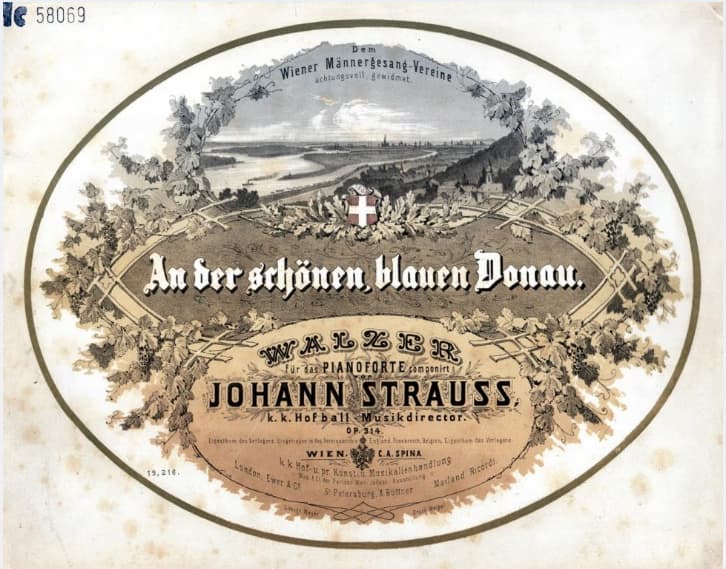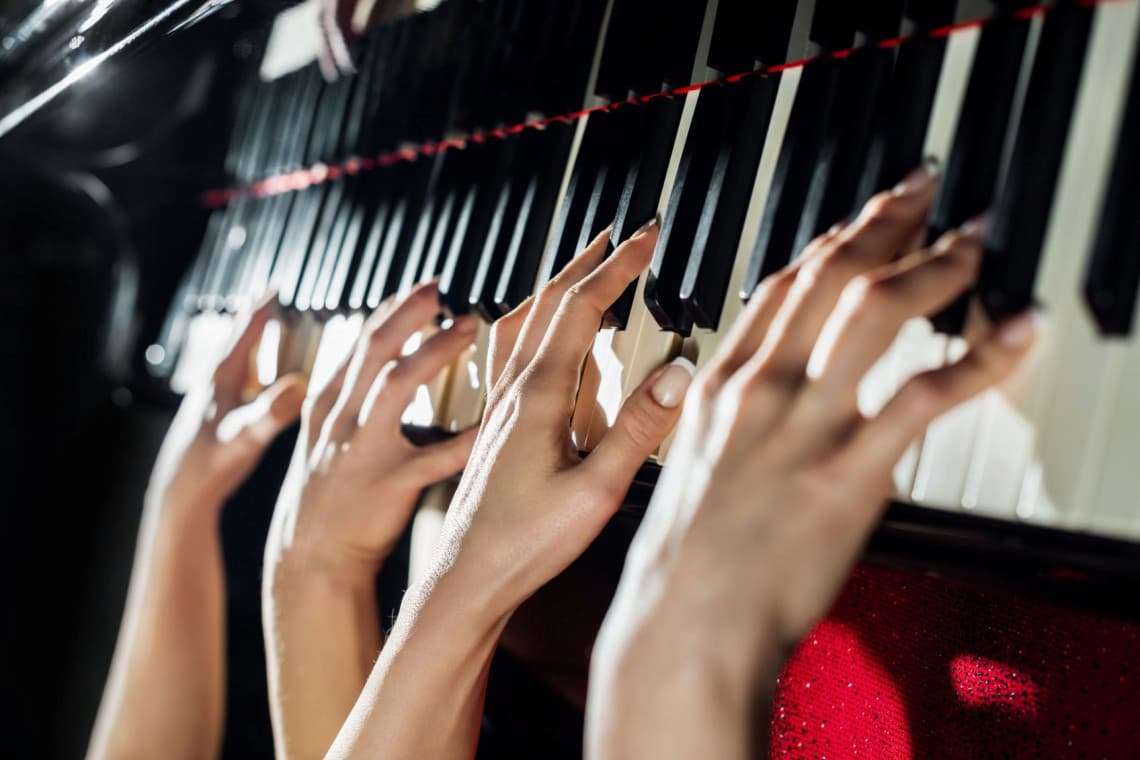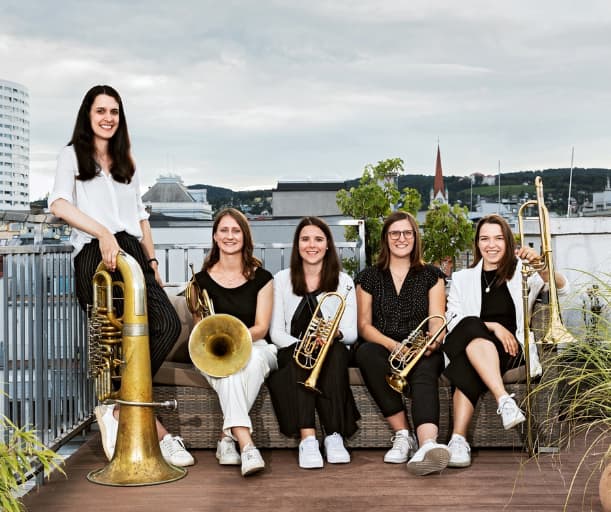If you love The Blue Danube, but didn’t happen to have an orchestra hanging about, there were many options for being able to play the piece at home, either by yourself or with friends.
For solo piano, the work is manageable.

The cover of the first edition for piano
Johann Strauss II: An der schönen, blauen Donau (The Beautiful Blue Danube), Waltz, Op. 314 (arr. A.J. Harison for piano) (Andri Joël Harison, piano)
If you had another friend, you could play an arrangement for piano 4-hands.

Piano Four Hands (Photo by L.A. Cicero)
Johann Strauss II: An der schönen, blauen Donau (The Beautiful Blue Danube), Op. 314 (arr. for piano 4 hands) (Duo Crommelynck)
No piano and only percussion? How about The Blue Danube for 2 marimbas?

Wings Marimba Ensemble
Johann Strauss II: An der schönen, blauen Donau (The Beautiful Blue Danube), Op. 314 (arr. Takayoshi Yoshioka for 2 marimbas) (Wings)
You with your guitar, and your two friends with a flute and a viola could do quite well by the piece.

Diabelli Trio
Johann Strauss II: An der schönen, blauen Donau (The Beautiful Blue Danube), Waltz, Op. 314 (arr. S. Schwab for flute, viola and guitar) (Diabelli Trio)
Ah, you have other friends with guitars? And there’s four of you? Perfect!

The Mississippi Guitar Quartet
Johann Strauss II: An der schönen blauen Donau (On the beautiful Blue Danube), Op. 314 (arr. M. Boyd) (The Mississippi Guitar Quartet)
You only have cello friends? There’s an arrangement for that!
Johann Strauss II: An der schönen, blauen Donau (The Beautiful Blue Danube), Op. 314 (arr. for 4 cellos) (La Quartina)
No stringed instruments around and you’re all brass players? The women’s brass ensemble, quinTTTonic, hails from all over Austria and came together in Vienna. They’ve written a new story for their arrangement of the work about a special surprise in the water!
It condenses the 10-minute original work by Strauss into just over 2 minutes, and they use it to tell of An Involuntary Trip to Braislava:
At Klosterneuburg it fell unnoticed into the water. At a leisurely pace it drifted down the beautiful, clay-yellow, dirty green, light green, grass-green, steel-green, emerald green, dark green and yet in our imagination always blue Danube. Brass music and smells waft over from the fisherman’s hut at Langenzersdorf, passing through Vienna on the Danube, which has long since been straightened. Past the Steinsporn Bridge it is almost rammed by a canoe. But even the canoeist doesn’t notice anything and continues paddling calmly. It continues staidly to Hainburg, but there, coming a little too close to the shore, a rascal tries to hit it with a stick. But his arms are too short. On the border between Czechoslovakia and Austria, it passes the empty Käsmacher Island; a patrol boat comes frighteningly close, but zigzags away in a different direction.
Only when the Danube sniffs into Bratislava, on the promenade below the Pekáč, does it get tangled up on the shore and is discovered by a little girl in uniform and rat tails and pulled out of the water. The latter looks over her shoulder, with an indefinite sense of guilt. Then she cracks open the cap expectantly, almost cuts her finger, nurses the well-travelled, chilled can of Coca-Cola – and doesn’t tell a soul about it.

quinTTTonic

Coke can in water
Johann Strauss II: An der schönen, blauen Donau (The Beautiful Blue Danube), Op. 314 (arr. A. Ladanyi for brass quintet) (quinTTTonic)
If all you have is your local brass band, there’s version for you, too!
Johann Strauss II: An der schönen, blauen Donau (The Beautiful Blue Danube), Op. 314 (arr. G. Richards for wind ensemble) (Sellers Engineering Band; Philip McCann, cond.)
As noted in the original story of The Blue Danube, it was originally a work for voices. Here it’s been arranged for the Vienna Boys Choir with orchestra. This version has the later lyrics by Franz von Gerneth, that praises the river as it flows through Vienna.
Donau so blau,
so schön und blau,
durch Tal und Au
wogst ruhig du hin,
dich grüßt unser Wien,
dein silbernes Band
knüpft Land an Land,
und fröhliche Herzen schlagen
an deinem schönen Strand.
Danube so blue,
so bright and blue,
through vale and field
you flow so calm,
our Vienna greets you,
your silver stream
through all the lands
you merry the heart
with your beautiful shores.
Johann Strauss II: An der schönen, blauen Donau (The Beautiful Blue Danube), Waltz, Op. 314 (arr. G. Wirth for boys choir and orchestra) (Vienna Boys Choir; Salonorchester Alt Wien; Gerald Wirth, cond.)
The French composer Franck Pourcel (1913–2000) took the idea of a vocal setting and transformed the work into a French chanson.
Johann Strauss II: An der schönen, blauen Donau (The Beautiful Blue Danube), Waltz, Op. 314 (arr. F. Pourcel for voice and orchestra) (Mady Mesplé, soprano; Franck Pourcel Orchestra; Franck Pourcel, cond.)
He also created an entire operetta made of Strauss waltzes and pieces and wrote another version of The Blue Danube for solo voice, choir, and orchestra.
Johann Strauss II: Walzer aus Wien (French version) (arr. E. Cools, J. Bittner and E.W. Korngold) – Act II: Le beau Danube bleu (Mady Mesplé, soprano; Rene Duclos Choir, Paris Opéra-Comique Orchestra; Jean Doussard, cond.)
The variety of Blue Danube is truly astonishing – this may be only the tip of the iceberg as these are the only ones that we found recordings of! Which is your favourite, and do you hear the work differently depending on the performing forces?
For more of the best in classical music, sign up for our E-Newsletter

